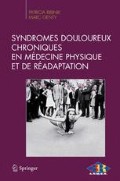Résumé
Comment prendre en charge médicalement les patients atteints de fibromyalgie? Importante question d’actualité qui offre de nombreuses solutions tant les patients atteints de fibromyalgie sont différents et ne répondent pas tous aux mêmes types de traitements. La première étape de la prise en charge consistera à valider le diagnostic de fibromyalgie en éliminant toutes les autres hypothèses possibles de douleurs articulaires ou musculaires. Ce point fondamental est souvent malheureusement négligé et les principaux diagnostics différentiels seront rappelés. Ensuite, il conviendra d’accompagner individuellement chaque patient selon son histoire douloureuse personnelle, ses symptômes et ses attentes. Différentes options thérapeutiques sont disponibles, elles seront exposées dans cette mise au point.
Preview
Unable to display preview. Download preview PDF.
Références
Haviland MG, Banta JE, Przekop P (2011) Fibromyalgia: prevalence, course, and co-morbidities in hospitalized patients in the United States (1999–2007). Clin Exp Rheumatol 29: S79–87
Wolfe F, Clauw DJ, Fitzcharles MA et al. (2010) The American College of Rheumatology preliminary diagnostic criteria for fibromyalgia and measurement of symptom severity. Arthritis Care Res (Hoboken) 62: 600–10
Taylor SS, Davis MC, Zautra AJ (2012) Relationship status and quality moderate daily pain-related changes in physical disability, affect, and cognitions in women with chronic pain. Pain. Oct 16 [Epub ahead of print]
Claudepierre P, Wendling D, Breban M et al. (2012) Ankylosing spondylitis, spondyloarthropathy, spondyloarthritis, or spondylarthritis: What’s in a name? Joint Bone Spine 79: 534–5
Miller FW (2012) New approaches to the assessment and treatment of the idiopathic inflammatory myopathies. Ann Rheum Dis 71 Suppl 2: i82–5
Hackett KL, Newton JL, Frith J et al. (2012) Impaired functional status in primary Sjögren’s syndrome. Arthritis Care Res (Hoboken) 64: 1760–4
Bayat N (2011) Symptoms of anxiety and depression: A comparison among patients with different chronic conditions. J Res Med Sci 16: 1441–7
Aggarwal R, Oddis CV (2011) Paraneoplastic myalgias and myositis. Rheum Dis Clin North Am 37: 607–21
Laroche M, Tack Y (1999) Hypophosphoremia secondary to idiopathic moderate phosphate diabetes: a differential diagnosis with primary fibromyalgia. Clin Exp Rheumatol 17: 628
Roskell NS, Beard SM, Zhao Y, Le TK (2011) A meta-analysis of pain response in the treatment of fibromyalgia. Pain Pract 11: 516–27
Rivera J, Vallejo MÁ, Esteve-Vives J, Grupo ICAF (2012) Drug prescription strategies in the treatment of patients with fibromyalgia. Reumatol Clin 8: 184–8
Arnold LM, Palmer RH, Gendreau RM, Chen W (2012) Relationships among pain, depressed mood, and global status in fibromyalgia patients: post hoc analyses of a randomized, placebo-controlled trial of milnacipran. Psychosomatics 53: 371–9
Uçeyler N, Häuser W, Sommer C (2008) A systematic review on the effectiveness of treatment with antidepressants in fibromyalgia syndrome. Arthritis Rheum59: 1279–98
Dharmshaktu P, Tayal V, Kalra BS (2012) Efficacy of antidepressants as analgesics: a review. J Clin Pharmacol 52: 6–17
González-Viejo MA, Avellanet M, Hernández-Morcuende MI (2005) A comparative study of fibromyalgia treatment: ultrasonography and physiotherapy versus sertraline treatment. Ann Readapt Med Phys 48: 610–5
Crofford LJ, Rowbotham MC, Mease PJ et al. (2005) Pregabalin for the treatment of fibromyalgia syndrome: results of a randomized, double-blind, placebo-controlled trial. Arthritis Rheum 52: 1264–73
Straube S, Derry S, Moore RA, McQuay HJ (2010) Pregabalin in fibromyalgia: meta-analysis of efficacy and safety from company clinical trial reports. Rheumatology (Oxford) 49: 706–15
Daniel D, Pirotta MV (2011) Fibromyalgia — should we be testing and treating for vitamin D deficiency? Aust Fam Physician 40: 712–6
Nizard J, Lefaucheur JP, Helbert M et al. (2012) Non-invasive stimulation therapies for the treatment of refractory pain. Discov Med 14: 21–31
Sañudo B, Carrasco L, de Hoyo M, McVeigh JG (2012) Effects of exercise training and detraining in patients with fibromyalgia syndrome: a 3-yr longitudinal study. Am J Phys Med Rehabil 91: 561–9
Wang C, Schmid CH, Rones R et al. (2010) A randomized trial of tai chi for fibromyalgia. N Engl J Med 363: 743–54
Terry R, Perry R, Ernst E (2012) An overview of systematic reviews of complementary and alternative medicine for fibromyalgia. Clin Rheumatol 31: 55–66
Author information
Authors and Affiliations
Corresponding author
Rights and permissions
Copyright information
© 2013 Springer-Verlag Paris
About this chapter
Cite this chapter
Goëb, V. (2013). Diagnostic et prise en charge thérapeutique des patients atteints de fibromyalgie. In: Syndromes douloureux chroniques en médecine physique et de réadaptation. Springer, Paris. https://doi.org/10.1007/978-2-8178-0439-2_5
Download citation
DOI: https://doi.org/10.1007/978-2-8178-0439-2_5
Publisher Name: Springer, Paris
Print ISBN: 978-2-8178-0438-5
Online ISBN: 978-2-8178-0439-2

